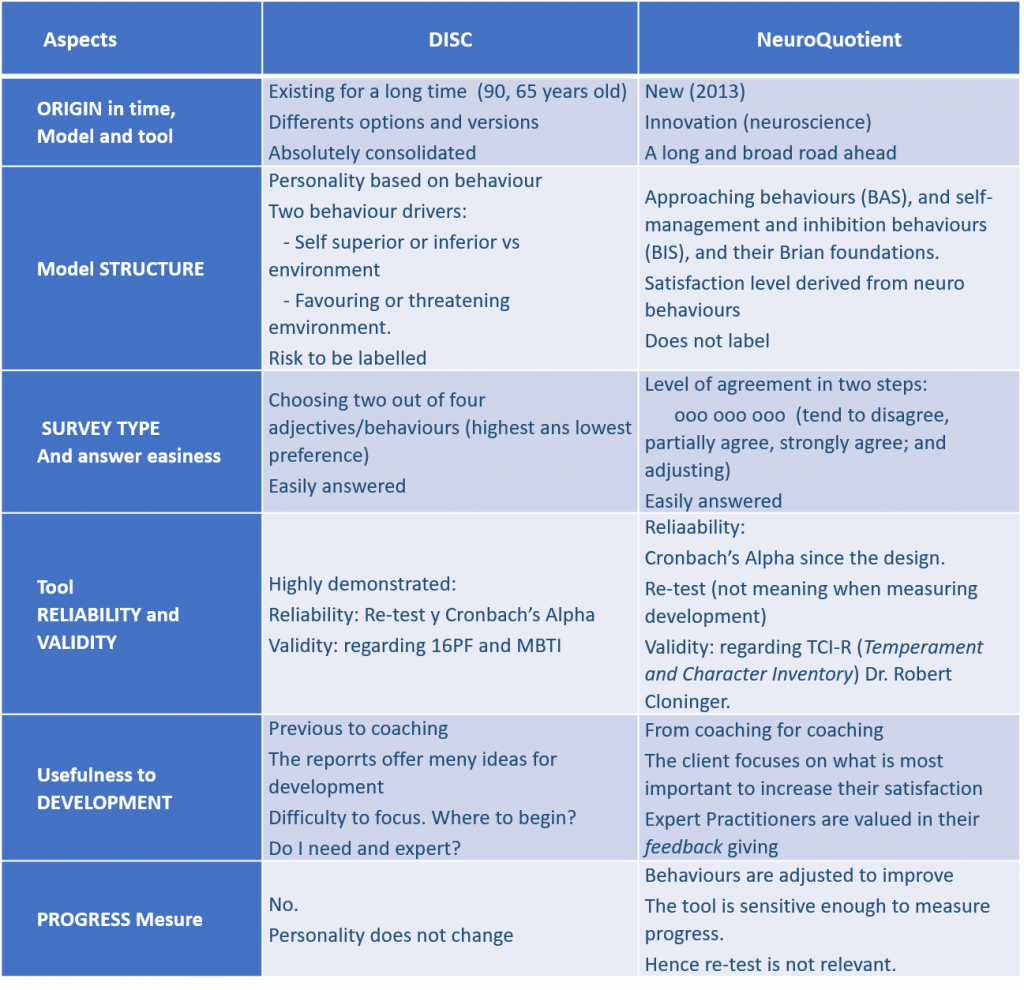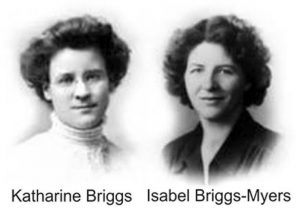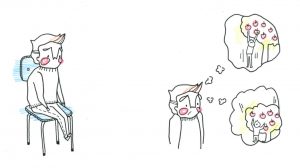It is likely that we are here looking for information about the DISC personality test. But, how we are attracted by innovation, we can also take the opportunity to learn about NeuroQuotient. The neuro tool that allows to apply neuroscience to coaching and people development in a practical and efficient way.
Anyway, if your interest does not go beyond the DISC personality test, you will find more information in this same blog – ” DISC model and DISC personality assessment tools for development (tools 5)”
In the current post we compare NeuroQuotient with the DISC personality test. So, we can see the most outstanding features of both tools.
Although, the best way to know NeuroQuotient, is to sign up for one of the free online workshops. And to continue with the Certification to be able to use the neuro tool to its full potential.
But, now, let’s follow another approach. We will take as reference the DISC personality test and we will compare it with NeuroQuotient in certain relevant aspects, seeing similarities and differences. The DISC personality test is the most widely used coaching and leadership development tool. We have already seen it in this blog.
As a mental note, the basic difference between the DISC personality test and NeuroQuotient is that DISC focuses on the personality whereas NeuroQuotient focuses on behaviour.
We will take into account the following aspects, which are summarized on the table below:
- Origin in time of the tools and their base model
- Model structure
- Survey type and answer easiness
- Reliability and validity of the tool
- Usefulness to development
- Progress measure
The most important practical difference between the DISC personality test and NeuroQuotient is that the neuro tool measures the progress in the development processes.

Origin in Time of the tools and their base model.
Remember: models explain a complex reality (personality, for example) in a simple way, and they make the agreement of its interpretation easier.
The tools, usually questionnaires or surveys, are used to measure how each element of the population fits inside the model (for example, which personality does each individual have.)
DISC (90 years since the model’s creation and 65 years since the first tool appeared) has a longer timeline and therefore it is absolutely consolidated.
The DISC model was created by William Mourton Marston and it was published in 1928 in Emotions of Normal People. It attempts to explain how emotions are expressed through behaviour. It describes the individuals’ way of being, their personality, through their behaviour or conduct. It is a model of personality traits.
The first DISC tool is from Walter V. Clarke in 1950. Others sprung up later. One of the most recent is Everything DISC.
NeuroQuotient (2013!) means innovation, regarding the application of neuroscience to the understanding of behaviour, and has a long and broad road ahead of it.
The model and the first NeuroQuotient tool appeared simultaneously in 2013. We present them in a primary training workshop to a group of 12 people.
Most of the responsibility (for better and for worse) of the creation of NeuroQuotient (tool and model) belongs to the writer of this article; always with the essential support and cooperation of other people, obviously. Especially regarding the tool.
NeuroQuotient is the result of a Project that started in 2009, with a Masters in Psychobiology and Cognitive Neuroscience. It continued with the study of many complex works in neuroscience foundations, to finally reach some very simple conclusions.
The NeuroQuotient model explains the behaviour (neurobehaviours) related to their brain foundations and takes into account the satisfaction derived from them.
It deals with all the behaviours -in a broader sense (thinking, feeling, and making)- that are directly related to the most relevant brain systems; and how are they turned into results (with more or less satisfaction) for each individual. It does not classify individuals regarding their behaviour. It is not a personality model.
It is necessary to illustrate it:
A model of personality traits, for example, would tell the individual: ‘you think before acting’, so ‘you are prudent’.
In NeuroQuotient, ‘you think before acting’ implies that the individual frequently uses their prefrontal cortex to calculate risks and to face the uncertainties of the future. Thus the individual calms down their fear system and feels tranquility. But they may also worry too much and non-willingly activate the fear they wanted to calm and end up feel stressed.
Do you observe the possibility of a bigger or lower satisfaction?
Comparing the DISC personality test and NeuroQuotient on their origin in time. The older age of DISC implies more experience, outreaching, agreement, study, diversity of uses, etcetera. NeuroQuotient, on the contrary, represents a new focus, with a longer and broader road ahead of it.
Model structure
DISC is structured by comparing how do we see ourselves regarding the environment and how do we see the environment.
The DISC model describes personality based on two main behaviour drivers stemming from emotion. One is internal (motor self), depending on the individuals’ perception of themselves as superior than their environment or inferior to it. And the other regards the environment (motor stimulus); depending on if it is perceived as an ally or as a threat.
The four DISC scales appear from the four resulting combinations of these two triggers: D (Dominance: superior to a threatening environment), I (Influence: superior to a favouring environment), S (Steadiness: inferior to a favouring environment), C (Compliance: inferior to a threatening environment).
We will not extend ourselves on them. You can delve into it on any website referring to DISC.
NeuroQuotient is shaped with the brain systems related to the approach (BAS, behaviour approach system) and inhibition and self-management (BIS, behaviour inhibition system). They can all bring us good or improvable results, depending on how we use them.
The NeuroQuotient model has four dimensions (A1, A2, I1, and I2). Behind them, several brain systems are involved. Each dimension has two sides, named efficiency and limitation, depending if the results derived from their associated behaviours are satisfactory or not to the individual.

The four dimensions derive from the basic animal behaviours (rewarding, fighting, fleeing and freezing) and the relationships between the PFC (prefrontal cortex) and the brain systems related to each dimension.
The A1 and A2 dimensions group together approach behaviours (BAS, behaviour approach system). Underlining the difference between attraction motivation (A1) and action (A2).
The I1 and I2 (BIS, behaviour inhibition system), group together inhibition behaviours in the limitation side and self-management in the efficiencies side. Study and prevention (I1) and focus towards others (I2).
A crucial difference between the DISC personality test and NeuroQuotient is that the latter does not mention personality, and therefore, avoids labelling people. On an individual level it eases the awareness of the results derived from one’s one neurobehaviours.
Type of questionnaire or survey and answer easiness
The DISC personality test and NeuroQuotient are easily answered. In the first one, one must choose the most preferred and least preferred adjectives (behaviours) from groups of four adjectives. In NeuroQuotient one must choose the degree of agreement to each behaviour.
The most frequent DISC questionnaires are based in behaviour-descriptive adjectives. They are grouped in groups of four, one per dimension (examples: enthusiast, fast, logical, nice; extroverted, cautious, tenacious, impatient). One must choose, in each group, two adjectives: the ones that better and least represent the individual.
In NeuroQuotient behaviours are included in sentences such as ‘I prefer routinary tasks’ or ‘I get nervous easily’. One must choose the degree of agreement by marking one of nine points, grouped in threes: ooo ooo ooo (tend to disagree, tend to agree, strongly agree). One must choose the group and tune up the answer inside the group.
The NeuroQuotient questionnaire is answered twice. One to determine the current state and another to determine the desired state.
Reliability and validity of a tool
It is accepted that tools must comply with two demands: to be reliable and valid. Reliability refers to being stable in time –meaning that it must always provide the same results-, and that there is an internal consistency between the items of the same dimension.
Stability in time is proved by re-testing the tool through time with the same population of study. Internal consistency is proved by the Cronbach’s Alpha
On the other side, a tool is valid when it measures what it says it measures. Validity is normally demonstrated by comparing it to a tool that is consolidated enough.
The DISC reliability and validity are widely demonstrated. For NeuroQuotient its validity has been proved by comparing it to TCI-R (Temperament and Character Inventory), and its reliability or internal consistency to the Cronbach’s Alpha.
The reliability and validity of DISC are totally demonstrated. This is logical regarding their long road.
You can access a study published on classic DISC from here. One of the validity studies is made regarding 16PF and another regarding MBTI
To NeuroQuotient internal consistency with the Cronbach’s Alpha comes inherently. During the process of design of the model and tool, the items (questions) were chosen from a first version, of a wider basis, regarding their grouping to the Cronbach’s Alpha.
Re-testing has also been made, with excellent results on a short period of time. But, as we will see on following sections, the fact that results are stable through time is against the very own definition of a tool designed for the development and measurement of progress.
To validate NeuroQuotient we compared it to TCI-R (Temperament and Character Inventory) from Doctor Robert Cloninger in its version with all the subscales. It was the only psychobiological tool we found out.
It is not the moment to describe the results of the validation study. This can be found in the documentation of the Certification in NeuroQuotient and they are briefly described in the free Introductory Webinar. We will only mention that not only does it have great correlations, but seeing how the scales and subscales of TCI-R fit with the NeuroQuotient dimensions, it has also been a great help to reassure us of our model.
Usefulness to the development
We mentioned coaching and leadership development tools. This is where another main difference between the DISC personality test and NeuroQuotient lies.
The current promoters of DISC have seen and taken the chance to get close to coaching. But the beginnings of coaching source from the late eighties, with Tim Galwey and John Withmore, and DISC and most of the tools were born in the fifties.
NeuroQuotient was born from coaching for the coaching (and psychology, and marketing, etc) with neuroscience!
What makes the biggest difference between the DISC personality test and NeuroQuotient is that this last tool is thought from coaching and development. It intends to ease the focus and give more value to the coach transmitting the results. The DISC reports, albeit very good, are long and may make these aspects more difficult.
DISC offers reports with lots of very good information. Depending on the version, they include not only the profile and its description but also suggestions of communication, identification of improvement points and even guides to progress.
We see it as a great strength. The client pays for something tangible: lots of information.
But it may also present with some disadvantages:
Usually, so much information does not help identifying the prioritary issues, and it makes the efficiency of processes more difficult.
With so much information, the client may not feel identified with its totality, generating a risk of a 15% of the information invalidating all the rest.
If we deliver a long report, which the client may even answer online, why would they need a coach or a psychologist or a consultant?
Since its beginnings, NeuroQuotient has three purposes: focus, simplicity and giving more value to the expert, coach, psychologist or consultant.
The focus is very fast: it only requires the client to compare the current state and the desired one: efficiencies to increase, limitations to decrease.
Reports are simple and include a short text. There is a version with blank space for the client to write down notes. The most important points of the results are transmitted by the expert (Certified Practitioner) with their feedback. This way, the client feels more identified with the results and establishes a trust and credibility bond with the expert, not the tool.
The most usual opinion of clients we hear is: ‘This person is an expert and he understands me’.
Progress measurement
Personality does not change, but we can adjust the intensity of behaviours to improve results, our satisfaction. NeuroQuotient is sensitive enough to measure this improvement.
During the coaching processes people tend to ask us about the measurement of progress.
This is another substantial difference between the DISC personality test and NeuroQuotient. DISC is based on a personality model. It is difficult for personality to change, and it is not modified at all during the usual time that a coaching process takes place.
The DISC profiles at the beginning and the end of a process are the same. The great reliability of DISC regarding the stability is the demonstration that it is not useful to measure progress.
Oppositely, NeuroQuotient refers exclusively to behaviours. They are really adjustable during the process. We can decrease or increase their frequency to improve satisfaction.
Moreover, the nine points answer system is sensitive enough to detect these modifications.
As we previously mentioned, we are not worried by the stability of the tool regarding how similar would be its results in the re-test. On the contrary, this is one of its positive distinguishing traits.
We hope this detailed article comparing the DISC personality test and NeuroQuotient proves itself useful to you to start understanding the neuro tool. In any case, and as we said at the beginning, the best way to do it is through the Free Introductory Workshops. And if it is already clear for you, you can Certify in NeuroQuotient (although first we will ask you to try the neuro tool).




